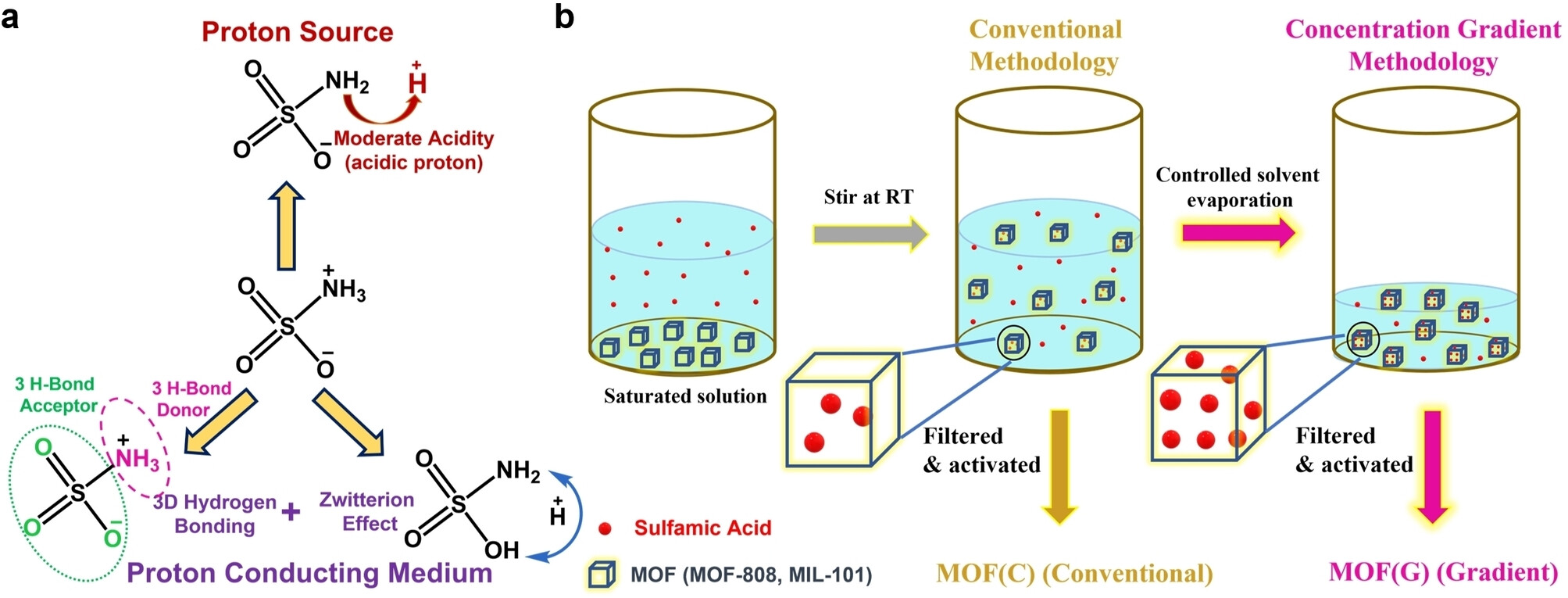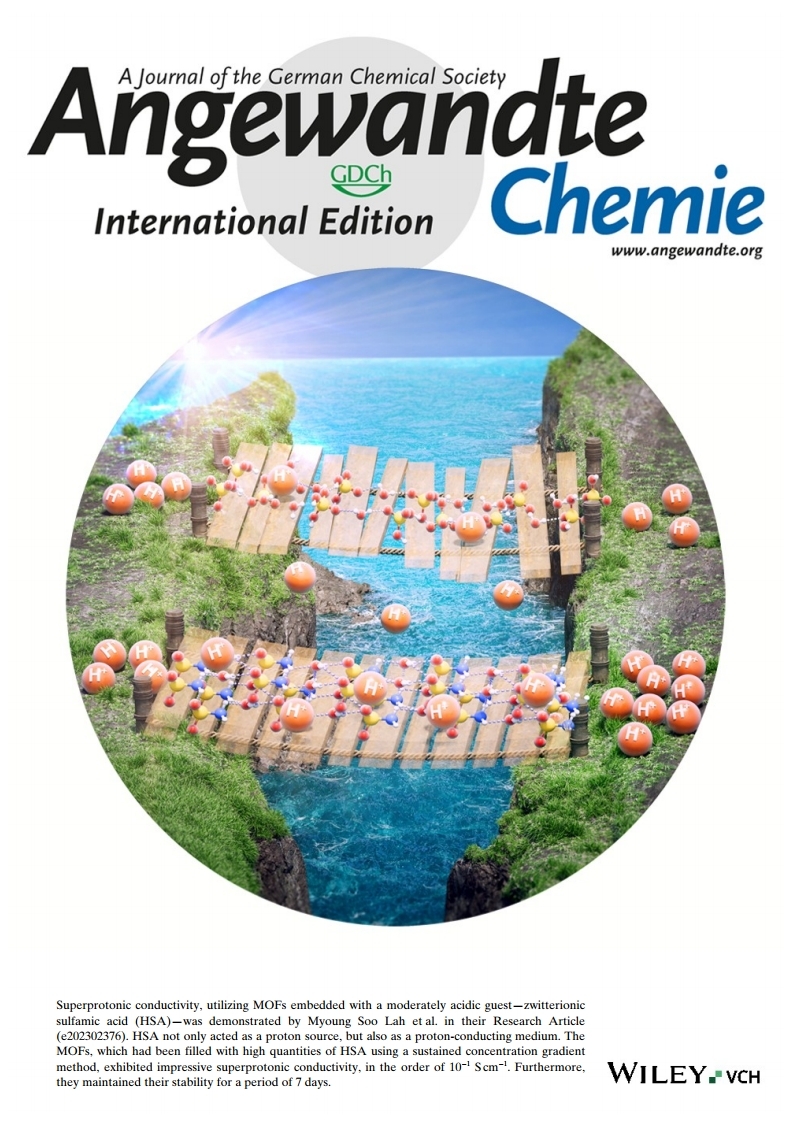We reach more than 65,000 registered users in Dec!! Register Now

New Ionic Materials Boost Hydrogen Fuel Cell Efficiency!
- September 17, 2023
- 15 Views
- 0 Likes
- 0 Comment
A few metal–organic frameworks (MOFs), which typically use strong acids as proton sources, display superprotonic conductivity (≈10−1 S cm−1); however, they are rare due to the instability of MOFs in highly acidic conditions. For the first time, we report superprotonic conductivity using a moderately acidic guest, zwitterionic sulfamic acid (HSA), which is encapsulated in MOF-808 and MIL-101. HSA acts not only as a proton source but also as a proton-conducting medium due to its extensive hydrogen bonding ability and zwitterion effect. A new sustained concentration gradient method results in higher HSA encapsulation compared to conventional methods, producing 10HSA@MOF-808-(bSA)2 and 8HSA@MIL-101. These MOFs show impressive superprotonic conductivity of 2.47×10−1 and 3.06×10−1 S cm−1, respectively, at 85 °C and 98 % relative humidity, and maintain stability for 7 days.
A team of researchers, affiliated with UNIST has made a groundbreaking advancement in improving the efficiency of hydrogen fuel cells, which are gaining significant attention as eco-friendly next-generation energy sources.
Led by Professor Myoung Soo Lah in the Department of Chemistry at UNIST, the team successfully developed solid electrolyte materials utilizing metal-organic frameworks (MOFs). This innovative approach significantly enhances the conductivity of hydrogen ions within the solid electrolyte employed in hydrogen fuel cells. Furthermore, the research team introduced guest molecules with low acidity—marking a pioneering achievement among intermediaries used for this purpose. By implementing a novel methodology that increases the number of guest molecules inside MOF pores, they achieved improved hydrogen ion conductivity.
 Figure 1: Schematic Illustration of HSA Properties and Synthesis Methodology.
Figure 1: Schematic Illustration of HSA Properties and Synthesis Methodology.Hydrogen fuel cells are highly efficient and environmentally friendly power generation devices that directly convert chemical energy derived from reactions between hydrogen and oxygen into electrical energy. Currently, Proton-Exchange Membrane Fuel Cells predominantly employ Nafion as an electrolyte material due to its thermal, mechanical, and chemical stability alongside high hydrogen ion conductivity. However, these systems face limitations regarding their operating temperature range and lack clarity on their mechanisms for performance enhancement.
The research team turned their attention to MOFs as potential alternatives. MOFs are materials composed of metal clusters interconnected by organic ligands to form a porous structure. With excellent chemical and thermal stability properties, MOFs have recently garnered considerable interest for use in fuel cell applications. Moreover, when generated, MOFs possess pores of varying sizes that can be utilized for developing materials with high hydrogen ion conductivity by introducing guest molecules through these channels.
In this study conducted by the research team at UNIST led by Professor Myoung Soo Lah’s group members , zwitterionic sulfamic acid—a low-acidity amphoteric ionic substance possessing both positive and negative charges—was introduced as guest molecules into two types of MOFs, namely MOF-808 and MIL-101. Sulfamic acid, a guest molecule with exceptional hydrogen bonding capabilities in various forms, effectively operates as a medium for transferring hydrogen ions. By increasing the amount of sulfamic acid within the pores of MOFs, the team successfully developed materials demonstrating high hydrogen ion conductivity (achieving levels of 10-1 Scm-1 or higher). Moreover, these materials exhibited remarkable durability as they maintained hydrogen ion conductivity over an extended period.
 Their findings have been selected for the back cover of Angew. Chem. Int. Ed. and published on June 20, 2023.
Their findings have been selected for the back cover of Angew. Chem. Int. Ed. and published on June 20, 2023.The research findings hold immense promise for advancing the efficiency and performance of hydrogen fuel cells through the utilization of metal-organic frameworks. This breakthrough contributes to accelerating progress toward sustainable energy solutions in line with global efforts towards decarbonization.
The study findings have been published ahead of their official publication in the online version of Angewandte Chemie International Edition on March 26, 2023. This work was selected for the back cover of the journal and was subsequently published on June 20, 2023.
List of Referenes
- Amitosh Sharma, Jaewoong Lim, Seonghwan Lee, Seungwan Han, Junmo Seong, Seung Bin Baek, Myoung Soo Lah. Superprotonic Conductivity of MOFs Confining Zwitterionic Sulfamic Acid as Proton Source and Conducting Medium. Angewandte Chemie International Edition, 2023; 62 (29) DOI: 10.1002/anie.202302376
Cite This Article as
No tags found for this post









